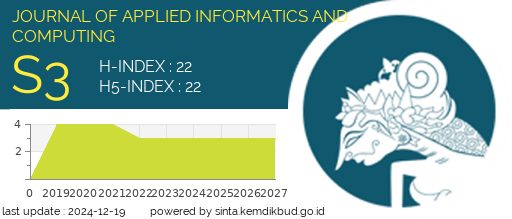Intelligent Web-Based Application for Personalized Obesity Management
DOI:
https://doi.org/10.30871/jaic.v9i3.9151Keywords:
BMI, Blackbox Testing, Deep Learning, K-Fold Cross Validation, ResNet-152Abstract
Obesity is a serious global problem due to its association with various chronic diseases. This study explores the utilization of machine learning in particular deep learning technology to predict Body Mass Index (BMI) from individual photos to create an efficient solution for assessing obesity. Using the ResNet152 model and K-Fold Cross Validation, this application integrates filters on individual photos to improve prediction accuracy. The application was developed using React JS for the front end, PHP and MySQL for the backend and database management, and Python as the core of the machine learning system. The application that tested using blackbox method, to see all features is functioning and the web application prototipe is passed all the test scenario.
Downloads
References
[1] D. W. Haslam and W. P. T. James, “Obesity,” The Lancet, vol. 366, no. 9492, pp. 1197–1209, Oct. 2005, doi: 10.1016/S0140-6736(05)67483-1.
[2] G. A. Bray, “Risks of obesity,” Endocrinol Metab Clin North Am, vol. 32, no. 4, pp. 787–804, 2003, doi: https://doi.org/10.1016/S0889-8529(03)00067-7.
[3] S. S. Bassuk and J. E. Manson, “Obesity/Overweight: Health Consequences,” in International Encyclopedia of Public Health, Second Edition., S. R. Quah, Ed., Oxford: Academic Press, 2017, pp. 277–294.
[4] J. M. Friedman, “Causes and control of excess body fat,” Nature, vol. 459, no. 7245, pp. 340–342, 2009, doi: 10.1038/459340a.
[5] “Obesity and overweight,” WHO. [Online]. Available: https://www.who.int/news-room/fact-sheets/detail/obesity-and-overweight
[6] G. Longo-Silva et al., “Breakfast skipping and timing of lunch and dinner: Relationship with BMI and obesity,” Obes Res Clin Pract, vol. 16, no. 6, pp. 507–513, 2022, doi: https://doi.org/10.1016/j.orcp.2022.10.012.
[7] K. Khullar, A. Agarwal, and S. S. du Plessis, “BMI and Obesity,” in Male Infertility: A Complete Guide to Lifestyle and Environmental Factors, S. S. du Plessis, A. Agarwal, and Jr. Sabanegh Edmund S., Eds., New York, NY: Springer New York, 2014, pp. 31–45. doi: 10.1007/978-1-4939-1040-3_3.
[8] K. M. Flegal, “BMI and obesity trends in Chinese national survey data,” The Lancet, vol. 398, no. 10294, pp. 5–7, Jul. 2021, doi: 10.1016/S0140-6736(21)00892-8.
[9] L. Wang et al., “Body-mass index and obesity in urban and rural China: findings from consecutive nationally representative surveys during 2004-18,” The Lancet, vol. 398, no. 10294, pp. 53–63, Jul. 2021, doi: 10.1016/S0140-6736(21)00798-4.
[10] C. A. Crispim, A. E. M. Rinaldi, C. M. Azeredo, D. J. Skene, and C. R. C. Moreno, “Is time of eating associated with BMI and obesity? A population-based study,” Eur J Nutr, vol. 63, no. 2, pp. 527–537, Dec. 2023, doi: 10.1007/s00394-023-03282-x.
[11] C. Rodríguez-Pardo et al., “Decision tree learning to predict overweight/obesity based on body mass index and gene polymporphisms,” Gene, vol. 699, pp. 88–93, 2019, doi: https://doi.org/10.1016/j.gene.2019.03.011.
[12] O. Tsave and I. Kavakiotis, “Biomarkers and Machine Learning Applications in Obesity,” in Obesity and Diabetes: Scientific Advances and Best Practice, J. Faintuch and S. Faintuch, Eds., Cham: Springer International Publishing, 2020, pp. 883–892. doi: 10.1007/978-3-030-53370-0_65.
[13] J. Gupta, S. Pathak, and G. Kumar, “Deep Learning (CNN) and Transfer Learning: A Review,” J Phys Conf Ser, vol. 2273, no. 1, pp. 1–10, May 2022, doi: 10.1088/1742-6596/2273/1/012029.
[14] A. Voulodimos, N. Doulamis, A. Doulamis, and E. Protopapadakis, “Deep Learning for Computer Vision: A Brief Review,” Comput Intell Neurosci, vol. 2018, no. 1, 2018, doi: https://doi.org/10.1155/2018/7068349.
[15] D. Bhatt et al., “CNN Variants for Computer Vision: History, Architecture, Application, Challenges and Future Scope,” Electronics (Basel), vol. 10, no. 20, 2021, doi: 10.3390/electronics10202470.
[16] J. Chai, H. Zeng, A. Li, and E. W. T. Ngai, “Deep learning in computer vision: A critical review of emerging techniques and application scenarios,” Machine Learning with Applications, vol. 6, p. 100134, 2021, doi: https://doi.org/10.1016/j.mlwa.2021.100134.
[17] K. He, X. Zhang, S. Ren, and J. Sun, “Deep Residual Learning for Image Recognition,” in 2016 IEEE Conference on Computer Vision and Pattern Recognition (CVPR), 2016, pp. 770–778. doi: 10.1109/CVPR.2016.90.
[18] E. I. Abd El-Latif and N. E. Khalifa, “COVID-19 digital x-rays forgery classification model using deep learning,” IAES International Journal of Artificial Intelligence, vol. 12, no. 4, pp. 1821–1827, Dec. 2023, doi: 10.11591/ijai.v12.i4.pp1821-1827.
[19] G. A. Shadeed, M. A. Tawfeeq, and S. M. Mahmoud, “Deep learning model for thorax diseases detection,” Telkomnika (Telecommunication Computing Electronics and Control), vol. 18, no. 1, pp. 441–449, Feb. 2020, doi: 10.12928/TELKOMNIKA.v18i1.12997.
[20] M. Outtas, L. Liu, J. R. Wolterink, R. Chen, and X. Li, “RETRACTED : A Survey of image pre-processing techniques for medical images Retraction Retraction: A Survey of image pre-processing techniques for medical images (J. Phys.: Conf. Ser. 1911 012003),” 2021.
Downloads
Published
How to Cite
Issue
Section
License
Copyright (c) 2025 I Gusti Ngurah Lanang Wijayakusuma, Made Sudarma, I Ketut Gede Darma Putra, Oka Sudana, Minho Jo

This work is licensed under a Creative Commons Attribution-ShareAlike 4.0 International License.
Authors who publish with this journal agree to the following terms:
- Authors retain copyright and grant the journal right of first publication with the work simultaneously licensed under a Creative Commons Attribution License (Attribution-ShareAlike 4.0 International (CC BY-SA 4.0) ) that allows others to share the work with an acknowledgement of the work's authorship and initial publication in this journal.
- Authors are able to enter into separate, additional contractual arrangements for the non-exclusive distribution of the journal's published version of the work (e.g., post it to an institutional repository or publish it in a book), with an acknowledgement of its initial publication in this journal.
- Authors are permitted and encouraged to post their work online (e.g., in institutional repositories or on their website) prior to and during the submission process, as it can lead to productive exchanges, as well as earlier and greater citation of published work (See The Effect of Open Access).











